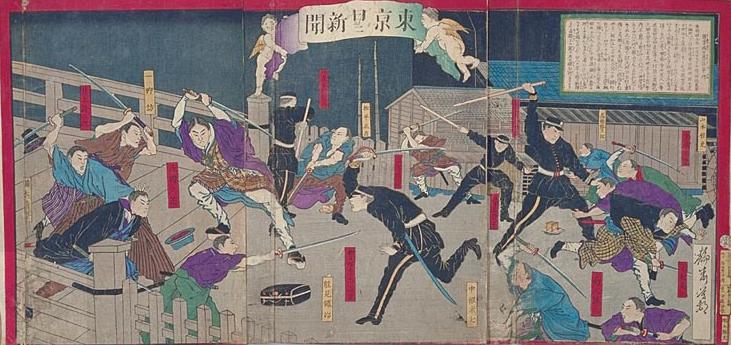
|
Above: TNS-9003o Tokyo Shianbashi incident
Copped and cropped from Rikken Collection (CCMA 2008)
|
Below: TNS-9003r Kumamoto Anseibashi attack
Copped and cropped from Rikken Collection (CCMA 2008)
|

|
Tokyo nichinichi shinbun
No. 9003 (Unnumbered)
1876-10-29 (Incident)
1876-12 (Notification)
Tokyo Shianbashi incident
Kumamoto Anseibashi attack
Stories in brief
TNS-9003o / Incident of rioters at Shianbashi
The main protagonist in the Shianbashi incident was Nagaoka Hisashige (1840-1877) -- the gallant figure in purple, brown, and white, center-left of TNS-9003. Nagaoka, an Aizu retainer, had helped at least one other Aizu retainer go to Hagi, in Yamaguchi prefecture, the heart of the former Choshu domain, and make contact with Maebara Issei, the protagonist of the Hagi rebellion.
Nagaoka and a few others had burst into the office of a transport company and demanded that it immediatly dispatch a boat to take them to Nobuto in Shimofusa -- in present-day Chiba city, the capital of Chiba prefecture. The people at the company were suspicious of the men and reported them to a patrolman. The four officers named on the drawing rushed to the place and engaged the renegade shizoku. One officer was killed, and two were seriously wounded, but the insurgents were captured.
Also according to the story, Nagaoka planned to lead thirteen men in an attack on the Chiba prefecture office at Naruto. Four of the men who escaped were captured at Niigata.
Another Aizu instigator -- featured lower center right, in blue -- was Nakane Yoneshichi (中根米七). Evading capture, he joined Saigo Takamori's forces in Kumamoto. After their defeat, he returned to Aizu and disemboweled himself in the graveyard at Komyoji temple in Kitakata. Legend has it he threw his own intestines on the stones of the graves.
TNS-9003r / Picture of night attack at Anseibashi in Kumamoto prefecture by Kagoshima rioters
The story on the original print, about an incident at Shianbashi (Shian bridge) in Tokyo in October 1876, was replaced by a 15-graph title concerning an incident at Anseibashi (Ansei bridge) in Kumamoto in February 1877. But the name cartouches on the picture remain the same.
The title is in the same green and yellow cartouche that framed the story. But whereas the story was printed on a pink ground (which was typical of story cartouches), the title was printed on a white ground with red at the top and green at the bottom (which was commonly done in title cartouches).
In the Kumamoto incident, Saigo Takamori and his Satsuma army, which had left Kagoshima on 15 February 1877, surrounded Kumamoto Castle on 21 February 1877. Early in the morning of 8 April 1877, a contingent of government troops led by Major Oku Yasukata (奥保鞏) snuck through the rebel line along the Shiragawa by the castle, and forded the river about one-hundred meters upstream from the bridge (also known as Yasumibashi).
Oku's force succeeded in provisioning the troops in the besieged castle. Saigo's forces were routed, and the castle, liberated on 15 April.
By fall, "the last samurai" and the rebellion he somewhat reluctantly lead were dead.
|

